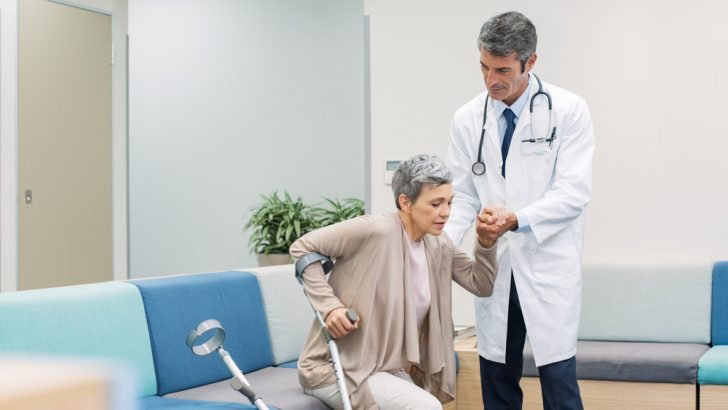Medical Matters
Falls and fractures are common in older adults and contribute to a significant morbidity and mortality. Falls are associated with social isolation and depression due to fear of further falls and indeed recurrent falls is one of the leading reasons for nursing home admission. One third of those aged over 65 fall at least once or more per year, rising to 50% in those aged over 80. Furthermore of those who fall, about 30% have recurrent falls and overall between 1-10% of falls result in serious injury including fracture.
Whilst falls and related injuries are not something that may be at the fore of our minds, many of us have older family members who are at risk of falling or have fallen with serious consequences. Many falls are classified as mechanical which often belies a more complex genesis with most occurring due to multi-factorial reasons. Overall, in 80% of cases gait imbalance is the predominant feature but other intrinsic factors often ultimately precipitate falls. Unfortunately, from the age of 40 muscle shrinkage can begin to occur and indeed by 65 there is an approximate 20-30% loss of muscle mass which can affect how we maintain our equilibrium.
Osteoarthritis
Unsteady gait is often due to osteoarthritis, silent mini-stroke disease and poor posture as a result of spinal wear and tear and even fractures.
But there are other important causes of falls that shouldn’t be missed. Blood pressure drops on standing often results in falls and is common with advancing age occurring in about 30% of those over 65. It is due to a blunting or loss of the normal reflex that makes the heart beat faster and blood vessels tighten to counteract the effects of gravity on blood flow. This often occurs in the morning and especially after getting up from lying flat after a long period, but is exacerbated by dehydration and blood pressure tablets. It often gives rise to transient dizziness or simply unsteadiness or staggering that resolves after a brief period.
It can be diagnosed by measuring lying and standing blood pressures. Some blood pressure tablets are more likely to cause such drops in which case they may need to be stopped or the dose reduced. Other tablets can also have the same affect including antidepressants and those used to treat prostatism. Ensuring adequate hydration and graduated postural changes like sitting on the edge of the bed for a few minutes before standing can be very helpful. In addtion, medications can be used.
Drop attacks or falls that happen without warning (especially if recurrent) may indicate the heart going too slow or pausing and may warrants cardiac rhythm monitoring and occasionally a pacemaker insertion.
Simple measures like ensuring correct foot wear and glasses, appropriate mobility aids and assessing factors like flooring, steps and hazards in the home is crucial in any approach to preventing falls.
Since zimmer frames were first developed in the 1950’s several other types of walking aids are now available including three and four wheel devices particularly suited for outdoors. However, sometimes aids can actually increase the risk of falls if not measured for the individual or if used incorrectly. Unfortunately, mobility aids including the simple walking stick are a visible sign of physical disability which often leads to an aversion to their use.
One of the biggest fears from falling is sustaining a hip fracture, the incidence of which rises exponentially with age. When older adults fall they tend not to react as quickly with their outstretched hand and the hip is more likely to receive impact, especially with falls sideways. In addition, about 50% of adults over 65 have some degree of brittle bones and indeed in severe osteoporosis fracture can occur prior to hip impact.
Your chances of hip fracture are greater if you are taller, have a parent with hip fracture (genetic factors) and fall on a hard surface. If you have a fat pad around the hip due to being overweight, it may be protective by absorbing the impact and appears to reduce your risk of fracture!
Protectors
On a similar vein, hip protectors (specially padded underwear) which are commercially available and have been extensively tested appear to reduce the risk of fracture and are suitable for some with severe osteoporosis.
Crucial to preventing fractures is also maintaining good bone health. All males over 70 and females over 65 should consider getting a DXA scan to check for brittle bones. If you are at risk of falls, vitamin D supplementation may also be benefical both for bone health but also in reducing falls by improving muscle strength. Regular exercise, physiotherapy with gait training and even Tai Chi have all been shown to reduce falls.
Falls can have a serious impact and its always important to look for secondary causes. When frequent there should be an assessment by a geriatrician and multidisciplinary team including physiotherapy and occupational therapy. Remember too, that if you’re at risk of falling, take great care this winter to avoid any slippery conditions.
*Dr Kevin McCarroll is a Consultant Physician in Geriatric Medicine, St James’s Hospital, Dublin.


 Dr Kevin McCarroll
Dr Kevin McCarroll
